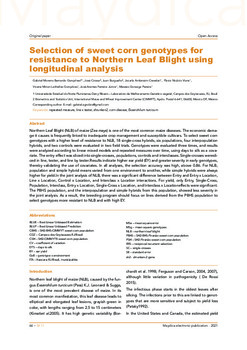Mostrar el registro sencillo del ítem
Selection of sweet corn genotypes for resistance to northern leaf blight using longitudinal analysis
| Creador: | Gonçalves, G.M.B. |
| Creador: | Crossa, J. |
| Creador: | Burgueño, J. |
| Creador: | Crevelari, J.A. |
| Creador: | Viana, F.N. |
| Creador: | Gonçalves, V.M.L. |
| Creador: | Ferreira Júnior, J.A. |
| Creador: | Pereira, M.G. |
| Año: | 2021 |
| URI: | https://hdl.handle.net/10883/21608 |
| Lenguaje: | English |
| Editor: | Consiglio per la Ricerca e la Sperimentazione in Agricoltura |
| Copyright: | CIMMYT manages Intellectual Assets as International Public Goods. The user is free to download, print, store and share this work. In case you want to translate or create any other derivative work and share or distribute such translation/derivative work, please contact CIMMYT-Knowledge-Center@cgiar.org indicating the work you want to use and the kind of use you intend; CIMMYT will contact you with the suitable license for that purpose |
| Tipo: | Article |
| Lugar de publicación: | Bergamo (Italy) |
| Número: | 2 |
| Volumen: | 66 |
| Palabras Claves: | Repeated Measure |
| Palabras Claves: | Line × Tester Analysis |
| Palabras Claves: | Shrunken2 |
| Palabras Claves: | Corn Diseases |
| Palabras Claves: | Exserohilum turcicum |
| Descripción: | Northern Leaf Blight (NLB) of maize (Zea mays) is one of the most common maize diseases. The economic damage it causes is frequently linked to inadequate crop management and susceptible cultivars. To select sweet corn genotypes with a higher level of resistance to NLB, 18 single-cross hybrids, six populations, four interpopulation hybrids, and two controls were evaluated in two field trials. Genotypes were evaluated three times, and results were analyzed according to linear mixed models and repeated measures over time, using days to silk as a covariate. The entry effect was sliced into single-crosses, populations, controls and interclasses. Single-crosses weresliced in line, tester, and line by tester.Results indicate higher ear yield (EY) and greater severity in early genotypes, thereby validating the use of covariates. In all analyses, the selection accuracy was high, above 0.86. For NLB, population and simple hybrid means varied from one environment to another, while simple hybrids were always higher for yield.In the joint analysis of NLB, there was a significant difference between Entry and Entry x Location, Line x Location, Control x Location, and Interclass x Location interactions. For yield, only Entry, Single-Cross, Population, Interclass, Entry x Location, Single-Cross x Location, and Interclass x Locationeffects were significant. The P8HS population, and the interpopulation and simple hybrids from this population, showed less severity in the joint analysis. As a result, the breeding program should focus on lines derived from the P8HS population to select genotypes more resistant to NLB and with high EY. |
| Agrovoc: | MAIZE |
| Agrovoc: | PLANT DISEASES |
| Agrovoc: | DISEASE RESISTANCE |
| Agrovoc: | SETOSPHAERIA TURCICA |
| ISSN: | 0025-6153 |
| Revista: | Maydica |
| Número de artículo: | M11 |
Ficheros en el ítem
Este ítem aparece en la(s) siguiente(s) colección(ones)
-
Genetic Resources
Genetic Resources including germplasm collections, wild relatives, genotyping, genomics, and IP

